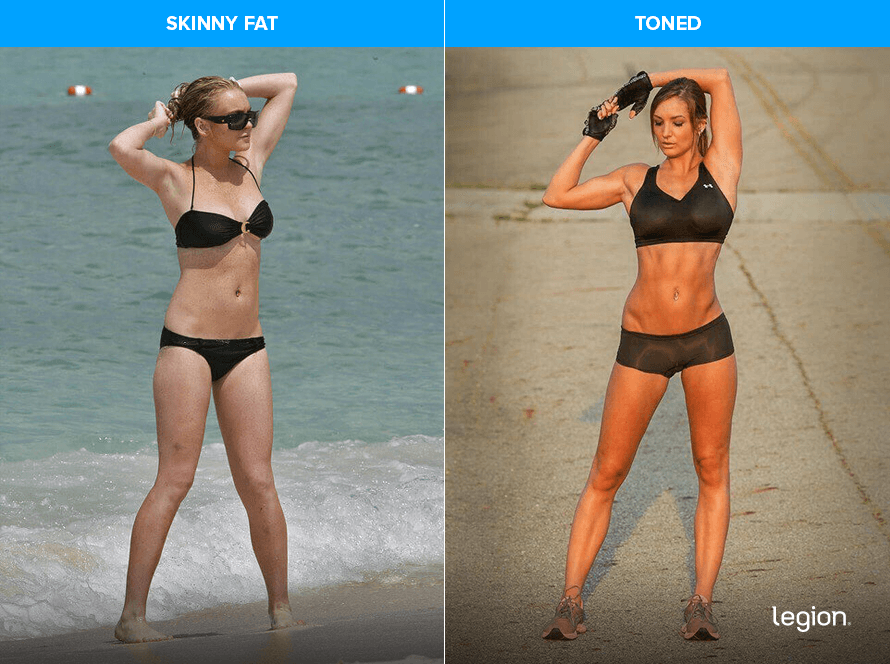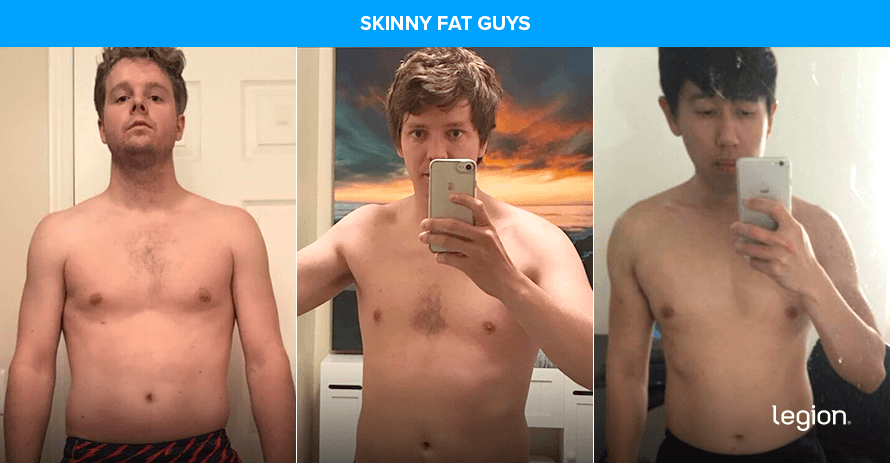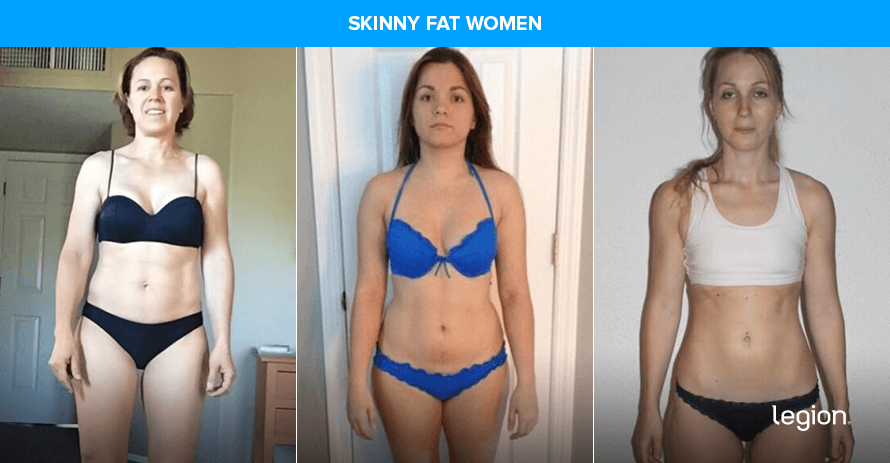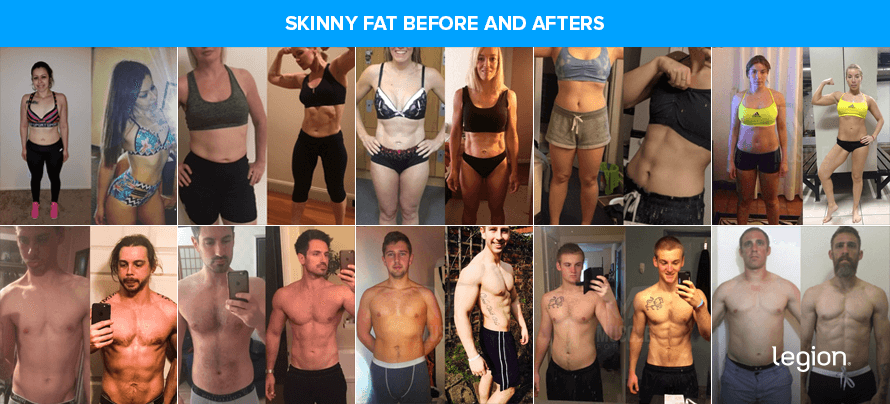If you think you might be “skinny fat” and you want to know how to get rid of skinny fatness, you’re in the right place.
But first, what is skinny fat? And what does skinny fat look like?
Someone with a skinny fat body type has too little muscle mass and too much body fat. They often look normal or even skinny when wearing clothes, but look soft and flabby underneath. In other words, they’re skinny and fat simultaneously.
Skinny fatness often afflicts people who think they’re doing everything right with their diet and workouts. You’ve probably seen or experienced this yourself: you go to the gym regularly, do cardio every week, eat “clean,” and yet still look skinny fat.
So, what causes skinny fatness and how can you get rid of it?
You become skinny fat by making a handful of simple diet and training mistakes. Namely, severely restricting your calories, undereating protein, doing little or no strength training, or doing excessive cardio.
Fortunately, learning how to get rid of skinny fat isn’t too tricky. In this article, you’ll discover everything you need to know about how to fix skinny fat.
We’ll also provide skinny fat example pictures, so you understand exactly what skinny fat is (and isn’t), guidance on the health implications of being skinny fat, and more.
Table of Contents
What Is Skinny Fat?
The term “skinny fat” describes a condition where someone with a relatively healthy body weight has too little muscle and too much body fat, giving them a shapeless, undefined look.
Even if you have a relatively healthy weight or body mass index (BMI), it’s possible to have a skinny fat physique if you also have little muscle.
Many women find this hard to comprehend, as they tend to be more concerned with losing fat (and reaching or maintaining a specific weight) than building muscle.
However, while losing weight can be helpful for improving your physique, it’s not as important as optimizing your body composition. For example, check out these pictures:

These women have similar body fat percentages. Despite the woman on the right being slightly leaner, the difference in their physiques is the amount of muscle they have. The woman on the left has little and the one on the right has quite a bit.
This illustrates an important point: The less muscle you have, the more prone you are to looking skinny fat despite being at a healthy weight. An extremely under-muscled guy at 15% body fat can look skinny fat whereas a muscle-bound guy at the same level of body fat can look impressive.
What Does Skinny Fat Look Like? Skinny Fat Examples
What does skinny fat look like, you wonder?
Here are some skinny fat examples. First, here are some skinny fat men:

And here are some skinny fat women:

As you can see, the people in these skinny fat examples don’t look unhealthy, but they don’t really look “fit,” either.
Why Am I Skinny Fat?
The four main causes of a skinny fat body type are:
- Doing little or no strength training
- Eating too little protein
- Severely restricting calories
- Doing excessive cardio
Little or No Strength Training
The main cause of skinny fatness is not having enough muscle. Since weight training is the most effective way to maintain and build muscle mass, it’s also the best way to lose skinny fat.
Heavy, compound weightlifting is your golden ticket to fixing skinny fatness. You can make every other mistake on this list, but if you also do lots of heavy weightlifting, you’ll still build muscle and be less skinny fat than previously.
You don’t have to do much to reap the benefits, either: 2-to-3 weightlifting workouts weekly is enough to see improvements, and 4-to-5 workouts weekly is optimal.
Eating Too Little Protein
Eating too little protein deprives your body of the raw material it needs to build muscle, and thus makes it nearly impossible to gain muscle and strength. To make matters worse, eating too little protein also makes it harder to stay full after meals, increasing your chances of overeating and making fat loss more difficult.
A good rule of thumb is that you generally want to eat 0.8-to-1 gram of protein per pound of body weight per day, which works out to around 30-to-40% of your calories for most people.
Severe Calorie Restriction
Severe calorie restriction can result in rapid muscle loss, especially when you aren’t lifting weights, which promotes skinny fatness.
This is why I recommend a moderate calorie deficit of about 20-to-25% when losing fat. Research shows that, when combined with a strength training program and a high-protein diet, this deficit allows for rapid fat loss while also preserving muscle.
Excessive Cardio
While doing cardio can help you stay healthy and lean, doing excessive cardio contributes to skinny fatness by interfering with your ability to gain strength and muscle. When combined with a very low-calorie, low-protein diet, lots of cardio can also speed up muscle loss even further.
Thus, you want to do a moderate amount of cardio to stay healthy and lean, but not so much that it interferes with your weightlifting workouts.
How to Get Rid of Skinny Fat
Learning how to lose skinny fat isn’t as tricky as many think—you simply need to lose fat and build muscle. And for most people, that means “cutting” and “lean bulking.”
In most cases, people with a skinny fat body type should prioritize building muscle first, as this will have the greatest impact on their appearance and health.
Then, once you’ve built some muscle, focus on losing your excess body fat, and you’ll start seeing drastic improvements in your physique.
The one exception to this rule is if you’re new to proper weightlifting, in which case you can gain muscle and lose fat at the same time. Thus, beginner weightlifters should focus on losing fat first, as you’ll still be able to build a respectable amount of muscle while dieting.
Regardless of whether you cut or lean bulk first, here’s how to do it:
Do a lot of heavy compound weightlifting.
Most guides on how to get rid of skinny fat recommend ineffective training routines that won’t deliver the results you want.
To lose your skinny fat body type as quickly as possible, focus on the following:
- Compound exercises: A compound exercise is any exercise that targets multiple muscle groups at once. Studies show that compound exercises produce the greatest increases in metabolic rate, muscle mass, and strength, which means they’re the best type of exercise for increasing fat loss.
- Heavy weightlifting: Research shows that training with 75-to-85% of your one-rep max (weights that you can do 6-to-12 reps with before failing) builds more muscle and burns more fat than training with lighter weights.
- Progressive overload: To maximize the muscle-building and fat-burning effects of weightlifting, strive to add weight or reps to every exercise in every workout. This is known as progressive overload, and it’s the single most important driver of muscle growth.
And if you want proof that training in this way can turn your “skinny fat to fit,” check out these skinny fat before and afters from people that have done my Bigger Leaner Stronger and Thinner Leaner Stronger weightlifting programs:

Do a moderate amount of cardio.
The best way to include cardio in a weight loss regimen is to do as little as needed to reach your desired rate of weight loss and stay fit, and no more.
For best results do . . .
- At least two low- to moderate-intensity cardio workouts per week of 20-to-40 minutes each.
- One HIIT workout per week if you enjoy it.
- No more than 2-to-3 hours of cardio per week.
- Cardio and weightlifting on separate days. If that isn’t possible, lift weights first and try to separate the two workouts by at least 6 hours.
Diet properly.
Nailing your diet is key to getting rid of skinny fat.
Fortunately, the solution is simple: control your calorie intake, eat the right balance of protein, carbs, and fat, and prioritize nutritious foods.
Here’s what to do if you’re new to weightlifting and want to lose fat while gaining muscle:
- Eat in a calorie deficit: To lose weight, you must eat fewer calories than you burn (known as eating in a “caloric deficit”). When dieting to lose weight, eating between 8-to-12 calories per pound of body weight per day creates a 20-to-25% calorie deficit for most people, which is a good target to aim for to lose fat quickly and healthily.
- Eat the right balance of macronutrients: To lose weight as effortlessly and healthily as possible, aim to get 30-to-40% of your daily calories from protein, 20-to-30% of daily calories from fat, and the remainder of your daily calories from carbohydrates.
And here’s the plan if you’re an experienced weightlifter looking to build muscle before losing fat:
- Eat in a calorie surplus: To maximize muscle gain while minimizing weight gain from fat eat 110% of your total daily energy expenditure. That is, 10% more calories than you burn every day. You know you’re gaining weight correctly when you add 1-to-3 pounds per month as a man, and about half that as a woman.
- Eat the right balance of macronutrients: Eat 0.8-to-1 gram of protein per pound of body weight per day, get 20-to-30% of daily calories from fat, and get the remainder of your daily calories from carbohydrates.
Once you’re happy with your level of muscularity, begin cutting using the guidelines in this article:
How to Lose Weight Faster in 5 Simple Steps
In both scenarios, you should also prioritize nutritious foods. And that means getting most of your calories from fruits, vegetables, whole grains, lean meats, fish, dairy, pulses, nuts, seeds, legumes, and plant oils, and avoid processed foods, trans-fats, and high-sugar drinks.
Is Having a Skinny Fat Body Type Unhealthy?
Being “skinny fat” doesn’t automatically mean you’re unhealthy, but you could likely improve your health and lower disease risk by losing fat and gaining muscle.
While many believe a “healthy” BMI indicates good health, it doesn’t account for body composition. You can have a healthy BMI but still carry an unhealthy amount of fat.
Research even suggests that it’s possible to be “metabolically obese” at a normal weight, which increases risks like insulin resistance, high cholesterol, and high blood pressure. This is especially true if you have a lot of visceral fat (fat around your internal organs, not to be confused with fat under your skin, called subcutaneous fat), which is associated with many diseases and an early death. And in many cases, these people are also skinny fat.
Not every skinny fat person will have these health problems, but keeping body fat in check is crucial for reducing disease risk. Equally important from a health and longevity perspective is building and maintaining muscle mass.
A study from the University of California showed that individuals with both high body fat and muscle mass had a lower risk of dying from heart disease compared to those with low body fat and muscle mass.
In other words, having more muscle (even with some fat) could be healthier than being skinny fat. Other studies also show that those with more muscle mass have a reduced risk of diabetes and cancer, and a higher overall quality of life.
FAQ #1: How can I tell if I’m skinny fat?
There isn’t a precise definition of what qualifies as a “skinny fat” body type.
Unless you’re a metabolically obese, normal-weight person, it’s primarily a subjective determination based on how you look.
That said, a good rule of thumb is if you’re a guy somewhere between 10% and 20% body fat or a woman between 20% and 30% body fat, you’re not naturally muscular, and you haven’t done any strength training in the past year or so (or ever), you’re probably skinny fat.
FAQ #2: How long does it take to go from skinny fat to fit?
This depends on how skinny fat you are and how quickly you lose fat and build muscle.
That said, most people can go from skinny fat to fit in about 3-to-6 months of diligently following a proper diet and training program.
FAQ #3: Should I do cardio if I have a skinny fat body type?
Many people use cardio as a scapegoat for skinny fatness, but this is wrongheaded. While cardio can exacerbate the mistakes that lead to skinny fatness, it rarely causes it on its own.
In fact, physical activity such as cardio can help you avoid becoming skinny fat if you follow the guidelines in this article and use it to improve your body composition synergistically with a proper diet and strength training program.
So, while you don’t have to do cardio if you’re skinny fat, it will help if you do it intelligently.
+ Scientific References
- Ballor, D L, et al. “Resistance Weight Training during Caloric Restriction Enhances Lean Body Weight Maintenance.” The American Journal of Clinical Nutrition, vol. 47, no. 1, 1 Jan. 1988, pp. 19–25, academic.oup.com/ajcn/article/47/1/19/4694815, https://doi.org/10.1093/ajcn/47.1.19. Accessed 20 Oct. 2019.
- Helms, Eric R, et al. “Evidence-Based Recommendations for Natural Bodybuilding Contest Preparation: Nutrition and Supplementation.” Journal of the International Society of Sports Nutrition, vol. 11, no. 1, 12 May 2014, www.ncbi.nlm.nih.gov/pmc/articles/PMC4033492/, https://doi.org/10.1186/1550-2783-11-20.
- Soenen, Stijn, and Margriet S Westerterp-Plantenga. “Proteins and Satiety: Implications for Weight Management.” Current Opinion in Clinical Nutrition and Metabolic Care, vol. 11, no. 6, Nov. 2008, pp. 747–751, https://doi.org/10.1097/mco.0b013e328311a8c4.
- Durrant, M. L., et al. “Factors Influencing the Composition of the Weight Lost by Obese Patients on a Reducing Diet.” The British Journal of Nutrition, vol. 44, no. 3, 1 Nov. 1980, pp. 275–285, pubmed.ncbi.nlm.nih.gov/7437413/, https://doi.org/10.1079/bjn19800042. Accessed 12 Feb. 2024.
- Huovinen, Heikki T., et al. “Body Composition and Power Performance Improved after Weight Reduction in Male Athletes without Hampering Hormonal Balance.” Journal of Strength and Conditioning Research, vol. 29, no. 1, Jan. 2015, pp. 29–36, https://doi.org/10.1519/jsc.0000000000000619.
- Farinatti, Paulo TV, and Antonio G Castinheiras Neto. “The Effect of Between-Set Rest Intervals on the Oxygen Uptake during and after Resistance Exercise Sessions Performed with Large- and Small-Muscle Mass.” Journal of Strength and Conditioning Research, vol. 25, no. 11, Nov. 2011, pp. 3181–3190, https://doi.org/10.1519/jsc.0b013e318212e415.
- MARX, JAMES O., et al. “Low-Volume Circuit versus High-Volume Periodized Resistance Training in Women.” Medicine and Science in Sports and Exercise, Apr. 2001, pp. 635–643, https://doi.org/10.1097/00005768-200104000-00019.
- Schoenfeld, Brad J. “The Mechanisms of Muscle Hypertrophy and Their Application to Resistance Training.” Journal of Strength and Conditioning Research, vol. 24, no. 10, 2010, pp. 2857–72, https://doi.org/10.1519/JSC.0b013e3181e840f3.
- Iraki, Juma, et al. “Nutrition Recommendations for Bodybuilders in the Off-Season: A Narrative Review.” Sports, vol. 7, no. 7, 26 June 2019, p. 154, www.ncbi.nlm.nih.gov/pmc/articles/PMC6680710/, https://doi.org/10.3390/sports7070154.
- Ding, Cherlyn, et al. “Lean, but Not Healthy.” Current Opinion in Clinical Nutrition and Metabolic Care, vol. 19, no. 6, Nov. 2016, pp. 408–417, https://doi.org/10.1097/mco.0000000000000317.
- Sahakyan, Karine R., et al. “Normal-Weight Central Obesity: Implications for Total and Cardiovascular Mortality.” Annals of Internal Medicine, vol. 163, no. 11, 10 Nov. 2015, p. 827, annals.org/aim/article-abstract/2468805/normal-weight-central-obesity-implications-total-cardiovascular-mortality?resultClick=3, https://doi.org/10.7326/M14-2525.
- Srikanthan, Preethi, et al. “Relation of Muscle Mass and Fat Mass to Cardiovascular Disease Mortality.” American Journal of Cardiology, vol. 117, no. 8, 15 Apr. 2016, pp. 1355–1360, www.ajconline.org/article/S0002-9149(16)30155-2/fulltext, https://doi.org/10.1016/j.amjcard.2016.01.033.
- Haraldstad, Kristin, et al. “Changes in Health-Related Quality of Life in Elderly Men after 12 Weeks of Strength Training.” European Review of Aging and Physical Activity, vol. 14, no. 1, 30 May 2017, https://doi.org/10.1186/s11556-017-0177-3. Accessed 16 May 2020.
- Rizzoli, René, et al. “Quality of Life in Sarcopenia and Frailty.” Calcified Tissue International, vol. 93, no. 2, 5 July 2013, pp. 101–120, https://doi.org/10.1007/s00223-013-9758-y. Accessed 14 Aug. 2019.
- Caan, Bette J., et al. “The Importance of Body Composition in Explaining the Overweight Paradox in Cancer—Counterpoint.” Cancer Research, vol. 78, no. 8, 15 Apr. 2018, pp. 1906–1912, cancerres.aacrjournals.org/content/78/8/1906.short, https://doi.org/10.1158/0008-5472.CAN-17-3287. Accessed 24 Nov. 2020.
- Srikanthan, Preethi, and Arun S. Karlamangla. “Relative Muscle Mass Is Inversely Associated with Insulin Resistance and Prediabetes. Findings from the Third National Health and Nutrition Examination Survey.” The Journal of Clinical Endocrinology & Metabolism, vol. 96, no. 9, Sept. 2011, pp. 2898–2903, https://doi.org/10.1210/jc.2011-0435.











